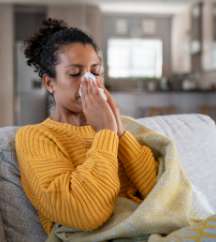
When most people think of allergy season, they think about spring and summer. The pollen that's released from flower buds and blooming trees is notorious for triggering allergies – sneezing, congestion, a runny nose and other bothersome symptoms are the norm for millions of people around this time of year. Even though snow, ice and freezing temperatures bring an end to spring and summer grass pollen season, many people find their allergies are worse in the winter. Why?
The most common allergens that trigger unwanted symptoms aren't found outside. Instead, they come from indoors, where there is less ventilation. This article will discuss the ins and outs of indoor winter allergies and some of the best ways to combat them.
Article Contents:
What Causes Winter Seasonal Allergies?
4 Common Causes of Indoor Winter Allergies
Symptoms of Wintertime Allergies
How to Manage Indoor Winter Allergies
Allergy Medication Can Drastically reduce Indoor Allergies
What Causes Winter Seasonal Allergies?
Common indoor allergens are the trigger for wintertime allergies – this is why they are more commonly referred to as indoor allergies [1]. Although present throughout the year, indoor allergies are worse in the winter than at any other time. This is because most people tend to stay cooped up inside during the cold weather, increasing exposure to the most common allergens. Keeping doors and windows shut while your heating system recirculates indoor air reduces ventilation, allowing allergens to build up quickly.
4 Common Causes of Indoor Winter Allergies
There is often no one cause of indoor winter allergies. Instead, there are several common allergens found inside our homes that flare up symptoms of fall allergies once we start spending more time indoors. Here are four of the most common causes of indoor allergies.
1. House Dust Mites
Dust mites are some of the worst culprits in developing winter seasonal allergies. They can cause allergies year-round, but you just may start to notice it more in the wintertime. These microscopic bugs live in house dust and eat the skin cells that people shed. Dust mites shed droppings and body parts that can build up and trigger wintertime allergies[2].
Dust mites prefer warm environments that attract dust, so they can end up being in your pillows, cozy winter blankets, mattresses, box springs and carpeting. These are ideal environments that can help them feed and reproduce. And if you have a humidifier going at greater than 50% humidity, you might be helping them grow faster.
2. Molds
Molds are parasitic, tiny fungi with spores that float in the air (the same as tree pollen does). Decaying leaves and typical yard waste give mold spores and mildew an ideal breeding ground outside. As you spend time outdoors, your shoes and clothes provide these damp, clingy irritants an easy way inside your home to make your allergies worse in the winter[3]. Mold can also grow in your basement, in the bathroom, under the sink or anywhere with running water, making it hard to escape their effects.
3. Pet and Animal Dander
Unfortunately, our furry friends are another common reason allergies are worse in the winter. If you have a cat or a dog that triggers your allergies, you might not notice it as much if they spend a lot of time outdoors during the spring, summer and fall months. Once the cooler air brings everyone inside, it increases your exposure to pet dander (fur, dead skin and dried saliva). Pet dander builds up quickly in bedding and carpets during winter, triggering some pretty harsh indoor allergies[4].
4. Cockroach Droppings
In urban locations, cockroaches are also a common trigger for wintertime allergies. Research indicates cockroach allergens are detected in 85% of all inner-city U.S. homes [5].
Cockroaches seeking a warm location during the cold winter months can slip into your home through windows and cracks in the walls or doors. Like dust mites, their sheddings, saliva, feces and body parts can trigger winter seasonal allergies. Prolonged exposure to cockroaches can even lead to sinus or ear infections [6].

Symptoms of Wintertime Allergies
How can you tell if you have indoor winter allergies? You'll most likely need to pay close attention to your symptoms and how long you're experiencing them. Common winter allergy symptoms to look out for include morning headaches, congestion, itchy eyes, runny nose, coughing, post-nasal drip and a sore or scratchy throat [7].
When these seasonal allergy symptoms appear during the colder months, you may think you have a cold or flu. However, cold and flu symptoms only last for around seven to ten days, while indoor allergies will last as long as you're exposed to the allergen (trigger) without treatment. It's also important to remember that colds and flu often come with a fever, while winter seasonal allergies do not.
How to Manage Indoor Winter Allergies
If your spring allergies already are bad in the winter, there are a few things you can do to make them more manageable. Maintaining a clean home during winter can significantly reduce exposure to winter allergens. Knowing how to control indoor dust and dander levels, and keeping your home mold and cockroach-free is challenging but not impossible. Here are some tips from the American College of Allergy, Asthma and Immunology (ACAAI) to proactively manage indoor allergies [1].
Use hypoallergenic covers or mite-proof zippered cases for mattresses and pillows.
Wash curtains, sheets and throw blankets regularly.
Vacuum any rugs or carpets in your home frequently to control indoor dust and dander levels. Be sure to sweep under beds and couches as well.
If you have a pet, limit their access to the bedroom whenever possible.
Bathe your cat or dog and wash pet bedding or cages frequently.
Use a premium air filter in your heating system to reduce indoor dust and dander levels.
Contact an exterminator if you suspect you have cockroaches. Keep all food sealed, and clean up any crumbs and spills.
Address any damp areas or leaks in the home. Cleaning damp areas can prevent mold and mildew from forming.
Allergy Medication Can Drastically Improve Indoor Allergies
If you feel like you've done everything you can to address your indoor allergies, but you're still suffering from symptoms, you may have to turn to allergy medication. Thankfully, there are numerous allergy medications and treatments available that may help you find indoor allergy relief [8].
The following over-the-counter and prescription allergy medications are perfect for addressing indoor allergies that are worse in the winter:
Antihistamines: Can help relieve sneezing, itching, a stuffy or runny nose and watery eyes. Common antihistamines used to help indoor winter allergies include Zyrtec and Allegra.
Corticosteroid Nasal Sprays: Can help address nasal congestion, stuffiness and sinus pressure caused by wintertime allergies. Common corticosteroids include Flonase and Nasocort.
Allergy Eye Drops: Can help with dry, red or itchy eyes. Common allergy eye drops for indoor allergy relief include Patanol, Optrex and Pataday eye drops.
Nasal Saline Solution: Can relieve the constant nasal congestion of wintertime allergies and resolve nasal dryness during cold weather.
Allergen Immunotherapy
Allergen immunotherapy, or AIT, is a more interdictory therapy, and is more commonly prescribed to treat food and outdoor allergies caused by pollens and insect stings. However, experience shows that AIT may be effective for combating more extreme cases of indoor allergies, where other procedures or medications fail to provide relief.
AIT involves giving increasing doses of the allergen via injection over a long period of time, which gradually desensitizes the immune system thus mitigating or even alleviating the symptoms. AIT must be administered under the supervision of a healthcare professional and often requires a significant time investment, and should likely be explored if symptoms are severe, or if other, more benign therapies prove to be ineffective.

Frequently Asked Questions: Indoor Winter Allergies
If you still have questions about why allergies can be worse in the winter, or just want more information about living with indoor winter allergies, check out the answers to our most frequently asked questions below.
Should I Use a Humidifier or Air Purifier for Indoor Allergies?
A good air purifier is a better solution for finding indoor allergy relief. Humidifiers can alleviate some symptoms during spring allergy season, but air purifiers can actively remove allergens from the air you breathe in the home.
Why Is Dust and Dander High in Winter?
Forced-air furnaces circulate more airborne dust containing lint, animal dander and bacteria at high levels in the winter because there is less ventilation. If you can, keep some windows open while cleaning to help get some fresh air in your home.

Find Affordable Medication for Indoor Winter Allergies at PlanetDrugsDirect.com
Indoor winter allergies can be a real challenge to manage. Thankfully there are plenty of effective solutions out there to help. By taking advantage of the low-cost and effective seasonal allergy and medication available from PlanetDrugsDirect.com, anyone can find the indoor allergy relief they need to enjoy the winter season again.



